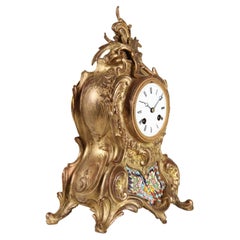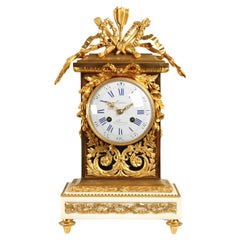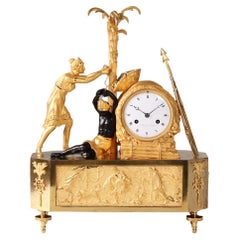Video Loading
Want more images or videos?
Request additional images or videos from the seller
1 of 22
19th Century Portal Mantel Clock with Date and open Escapement, Paris, c. 1870
$3,659.09List Price
About the Item
- Dimensions:Height: 19.69 in (50 cm)Width: 10.24 in (26 cm)Depth: 6.3 in (16 cm)
- Materials and Techniques:
- Place of Origin:
- Period:
- Date of Manufacture:1860-1870
- Condition:Refinished. Restored condition of movement and case. The watch runs absolutely reliable and accurate with a running time of circa 14 days.
- Seller Location:Greven, DE
- Reference Number:1stDibs: LU5419232366732
About the Seller
4.9
Platinum Seller
Premium sellers with a 4.7+ rating and 24-hour response times
Established in 2014
1stDibs seller since 2020
207 sales on 1stDibs
Typical response time: 1 hour
Authenticity Guarantee
In the unlikely event there’s an issue with an item’s authenticity, contact us within 1 year for a full refund. DetailsMoney-Back Guarantee
If your item is not as described, is damaged in transit, or does not arrive, contact us within 7 days for a full refund. Details24-Hour Cancellation
You have a 24-hour grace period in which to reconsider your purchase, with no questions asked.Vetted Professional Sellers
Our world-class sellers must adhere to strict standards for service and quality, maintaining the integrity of our listings.Price-Match Guarantee
If you find that a seller listed the same item for a lower price elsewhere, we’ll match it.Trusted Global Delivery
Our best-in-class carrier network provides specialized shipping options worldwide, including custom delivery.You May Also Like
Exquisite 19th Century Mantel Clock – Planchon Paris
Located in Stahnsdorf, DE
Exquisite 19th Century Mantel Clock – Planchon Paris
This exceptional mantel clock, crafted by the renowned Planchon manufactory in Paris during the second half of the 19th century,...
Category
Antique 1890s French Napoleon III Mantel Clocks
Materials
Bronze
19th Century French Empire Style Bronze Mantel Clock, circa 1870
Located in Royal Tunbridge Wells, Kent
Antique 19th century French Empire style gilt bronze mantle clock. The foliate and fruit engraved gilt-brass dial with enamel painted roman numerals. Inside with eight day movement w...
Category
Antique 19th Century French Empire Mantel Clocks
Materials
Brass, Bronze, Enamel
$4,145
Free Shipping
H 20.87 in W 8.27 in D 5.91 in
19th Century French Empire Style Ormolu Bronze Mantel Clock, c.1870
Located in Royal Tunbridge Wells, Kent
Antique 19th Century French Empire style ormolu bronze mantle clock. The foliate surround gilt dial, Inside with eight day movement with strike on bell. The top mounted with a figure...
Category
Antique 19th Century French Mantel Clocks
Materials
Bronze, Ormolu
$9,636
Free Shipping
H 20.87 in W 6.3 in D 18.12 in
19th Century French Mantel Clock, by 'Monbro Aine, Paris'
By Monbro Ainé 1
Located in Brighton, Sussex
A very good quality, large French 19th century gilded ormolu and white marble mantel clock, signed; 'Monbro Aine, Paris'. Having an urn of grapes with semi...
Category
Antique 1860s French Napoleon III Mantel Clocks
Materials
Marble, Ormolu
Magnificent French 19th Century Mantel Clock, Victor Paillard, Paris
By Victor Paillard
Located in Brighton, Sussex
A magnificent 19th century bronze mantel clock depicting allegorical figures representing Geography and literature. The white enamel clock face, Roman numerals, an eight day duration...
Category
Antique 19th Century French Classical Greek Mantel Clocks
Materials
Bronze
$113,839
H 26.78 in W 49.61 in D 11.82 in
Mantel Clock 19th Century Styl Empire by Leroy à Paris
Located in Warsaw, PL
A magnificent 19th-century Empire-style mantel clock, signed by the esteemed clockmaker Leroy à Paris. This timepiece exudes classical elegance, featuring a finely detailed gilt bron...
Category
Antique Early 19th Century French Empire Mantel Clocks
Materials
Bronze
Mantel Clock 19th Century Styl Empire by Bonieris À Paris
Located in Warsaw, PL
This elegant mantel clock is a true collector's piece. It features a beautifully sculpted gilt bronze case adorned with delicate details, including floral garlands and putti.
The cen...
Category
Antique Early 19th Century French Mantel Clocks
Materials
Bronze
Mantel Clock 19th Century Styl Empire by Hartmann À Paris
Located in Warsaw, PL
An exceptional 19th-century Empire-style mantel clock by Hartmann à Paris, meticulously crafted in gilt bronze. This distinguished timepiece showcases a finely detailed white enamel ...
Category
Antique Early 19th Century French Empire Mantel Clocks
Materials
Bronze
Mantel Clock 19th Century Styl Empire by Cérés À Paris
Located in Warsaw, PL
Empire clock signed à Paris
The mantel clock is in gilded bronze representing Ceres as a goddess of fertility, agriculture, grain crops and motherly relationships. In ancient Rom...
Category
Antique Early 19th Century French Empire Mantel Clocks
Materials
Bronze
19th Century Empire Mantel Clock
Located in Ljungby, SE
An Empire mantel clock in gilded wood, made in Austria or Germany 1820-1830. It features a warrior dressed in classical armor with his arm resting atop the clock. The clock pillar is...
Category
Antique 19th Century European Empire Mantel Clocks
Materials
Wood
More From This Seller
View AllEarly 19th Century French Empire Mantel Clock, Portal Pendule, Paris circa 1820
By Duval
Located in Greven, DE
Antique French round arch portal clock
France (Paris)
Bronze, enamel
Empire circa 1820
Dimensions: H x W x D: 47 x 26 x 12 cm
Description:
Very beautiful, strictly architecturally...
Category
Antique Early 19th Century French Empire Mantel Clocks
Materials
Bronze, Enamel
Late 19th Century Cloisonne Mantel Clock, circa 1870-1890
Located in Greven, DE
French mantel clock with cloisonné inlays
Paris
Gilt bronze, enamel, movement by E. Gaillot, Paris
c. 1880
Dimensions: H 32 × W 23 × D 15 cm
Description:
Elaborately designed mant...
Category
Antique Late 19th Century French Mantel Clocks
Materials
Bronze, Enamel
19th Century Parisian Mantel Clock in Louis XVI Style, signed Lepine, circa 1870
By Guillaume Denière, Samuel Marty, Lepine
Located in Greven, DE
Mantel Clock in Louis XVI style
Paris
Ormolu, glass, marble
around 1870
Dimensions: H x W x D: 46 x 24 x 17 cm
Description:
Extremely high quality and finely crafted Parisian pend...
Category
Antique 1870s French Louis XVI Mantel Clocks
Materials
Carrara Marble, Ormolu
Early 19th Century Ormolu Mantel Clock, Atala freeing Chactas, Paris, circa 1810
Located in Greven, DE
Mantel Clock "Atala and Chactas"
Paris
Bronze (fire-gilt and patinated), enamel
Empire around 1810
Dimensions: H x W x D: 40 x 32 x 11 cm
Description:
Very rare and extremely high quality French mantel clock, so-called Pendule Au Bon Sauvage.
Depicted are scenes from the love story "Atala or the love of two savages in the desert" written by Francois René Vicomte de Chateaubriand in 1801. At the beginning of the 19th century, this was probably the most famous love story in Europe, but today it has been forgotten.
The story, set in present-day Louisiana (USA), is roughly rewritten about the forbidden love between Chactas, a young Indian, and Atala, the beautiful daughter of a Spaniard.
Chactas is captured in a battle between two Indian tribes, chained to a palm tree and is to be sacrificed. Atala wants to save his life and convert him to Christianity. She unties him from the palm tree at night and they flee together into the wilderness of North America. Their love for each other grows stronger and stronger and they have prospects for a future together.
The story takes a tragic turn when Atala, who must remain a virgin due to a vow made by her mother, can no longer withstand the conflict of her feelings and commits suicide.
The main group of characters thus shows Chacta's liberation through Atala. Atala is leaning against a pile of logs. The animal fur thrown over the logs and the weapons leaning against the stack on the right give the impression of a night camp.
The bronze is of rarely beautiful quality, finely chiselled and makes the scene appear very lively. The contrast of fire-gilded and patinated bronze adds tension to the composition.
In the base we see the Entombment as the end of the tragic love story. This bronze work is also very detailed, the interplay of bright and matt gilding makes the flat relief appear much deeper than it is.
The depiction of the mantel clock presented here shows that the exotic was only known from stories and that the bronzier had his own ideas about the appearance of this distant world. The Indian, for example, has very European facial features and his skin was not black in reality, of course. The palm tree was also certainly not found in the North American wilderness.
The heart of the clock is a French pendulum movement, integrated into the wooden pile, with an eight-day power reserve and a lock plate striking a bell on the half and full hour. The pendulum is suspended on a thread, typical of the period. The classically shaped hands, so-called Breguet hands, are also typical of the time.
The enamelled dial has black Roman hour numerals, Arabic quarter hours and bears the signature: Le Roy hr. de Madame A PARIS.
Interesting facts:
The period from 1795 to about 1815 saw the creation of probably the most spectacular group of bronzes: The "Au bon Sauvage" pendulums - depictions of the "Noble Savage".
Today's viewers react to these objects with both fascination and irritation. Enthusiastic on the one hand about the obvious quality of the detailed bronzes and the allure of the exotic, on the other hand distanced and cautious because of the possible discrimination that is suspected behind them. The ambivalence of this feeling motivates the search for the conditions of origin of these pendulums.
Europeans found their new ideal of the natural man primarily in fictional and realistic travelogues about the Indians of North America...
Category
Antique Early 19th Century French Empire Mantel Clocks
Materials
Ormolu
Late 19th Century French Black Marble Mantel Clock
Located in Greven, DE
French Mantel Clock
Paris, circa 1870
Black marble with gilt bronze mounts
Dimensions: H × W × D: 41 x 23 x 12 cm
Description:
Case in black marble with richly chased and gilt bro...
Category
Antique Late 19th Century French Napoleon III Table Clocks and Desk Clocks
Materials
Marble, Bronze, Enamel
19th Century Mantel Clock "Astronomy", France circa 1830
Located in Greven, DE
Antique mantel clock on the theme of astronomy
France
Bronze
Charles X around 1830
Dimensions: H x W x D: 48 x 19 x 10 cm
Description:
Unusual and beautifully crafted bronze mante...
Category
Antique 19th Century French Charles X Table Clocks and Desk Clocks
Materials
Bronze
Recently Viewed
View AllMore Ways To Browse
Column Clock
Antique Clock Escapements
Dating Antique French Furniture
H H French Wood Mantel Clocks
Portal Clock
Open Escapement
Tiffany And Co Desk Clock
Vintage 8 Day Clock Clocks
Vintage Table Clock
German Art Deco Clock
Verge Escapement
Antique Bracket Clocks London
Antique Bronze Watch
Atmos Clocks
Blue Table Clocks
Cartier Clock Art Deco
Leather And Brass Desk Clock
Art Deco Bakelite Clocks



